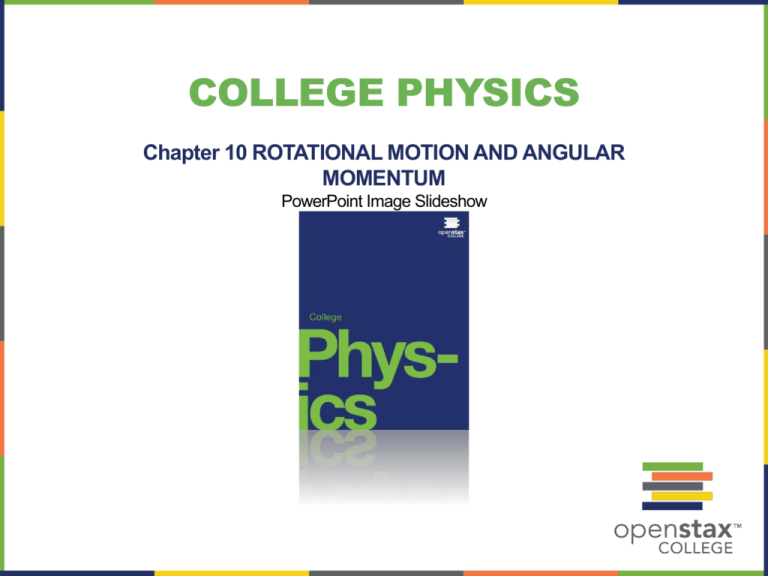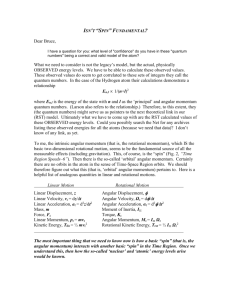
COLLEGE PHYSICS
Chapter 10 ROTATIONAL MOTION AND ANGULAR
MOMENTUM
PowerPoint Image Slideshow
FIGURE 10.1
The mention of a tornado conjures up images of raw destructive power. Tornadoes blow houses
away as if they were made of paper and have been known to pierce tree trunks with pieces of straw.
They descend from clouds in funnel-like shapes that spin violently, particularly at the bottom where
they are most narrow, producing winds as high as 500 km/h. (credit: Daphne Zaras, U.S. National
Oceanic and Atmospheric Administration)
FIGURE 10.2
This figure skater increases her rate of
spin by pulling her arms and her
extended leg closer to her axis of
rotation. (credit: Luu, Wikimedia
Commons)
FIGURE 10.3
This figure shows uniform circular motion
and some of its defined quantities.
FIGURE 10.4
In circular motion, linear acceleration 𝑎 ,
occurs as the magnitude of the velocity
changes: 𝑎 is tangent to the motion. In
the context of circular motion, linear
acceleration is also called tangential
acceleration 𝑎t .
FIGURE 10.5
Centripetal acceleration 𝑎𝑐 occurs as the
direction of velocity changes; it is
perpendicular to the circular motion.
Centripetal and tangential acceleration
are thus perpendicular to each other.
FIGURE 10.6
The linear acceleration of a motorcycle is accompanied by an angular acceleration of
its wheels.
FIGURE 10.8
Fishing line coming off a rotating reel moves linearly. Example 10.3 and Example 10.4
consider relationships between rotational and linear quantities associated with a fishing
reel.
FIGURE 10.9
The image shows a microwave plate. The fly makes revolutions while the food is
heated (along with the fly).
FIGURE 10.10
Force is required to spin the bike wheel.
The greater the force, the greater the
angular acceleration produced. The more
massive the wheel, the smaller the
angular acceleration. If you push on a
spoke closer to the axle, the angular
acceleration will be smaller.
FIGURE 10.11
An object is supported by a horizontal
frictionless table and is attached to a
pivot point by a cord that supplies
centripetal force. A force 𝐹 is applied to
the object perpendicular to the radius 𝑟,
causing it to accelerate about the pivot
point. The force is kept perpendicular to
𝑟.
FIGURE 10.12
Some rotational inertias.
FIGURE 10.13
A father pushes a playground merry-go-round at its edge and perpendicular to its radius
to achieve maximum torque.
FIGURE 10.14
The motor works in spinning the grindstone, giving it rotational kinetic energy. That
energy is then converted to heat, light, sound, and vibration. (credit: U.S. Navy photo by
Mass Communication Specialist Seaman Zachary David Bell)
FIGURE 10.15
The net force on this disk is kept perpendicular to its radius as the force causes the disk
to rotate. The net work done is thus (net F)Δs . The net work goes into rotational kinetic
energy.
FIGURE 10.16
Experimental vehicles, such as this bus, have been constructed in which rotational kinetic
energy is stored in a large flywheel. When the bus goes down a hill, its transmission converts
its gravitational potential energy into KErot . It can also convert translational kinetic energy,
when the bus stops, into KErot . The flywheel’s energy can then be used to accelerate, to go
up another hill, or to keep the bus from going against friction.
FIGURE 10.17
A large grindstone is given a spin by a person grasping its outer edge.
FIGURE 10.18
The first image shows how helicopters
store large amounts of rotational kinetic
energy in their blades. This energy must
be put into the blades before takeoff and
maintained until the end of the flight. The
engines do not have enough power to
simultaneously provide lift and put
significant rotational energy into the
blades. The second image shows a
helicopter from the Auckland Westpac
Rescue Helicopter Service. Over 50,000
lives have been saved since its
operations beginning in 1973. Here, a
water rescue operation is shown. (credit:
111 Emergency, Flickr)
FIGURE 10.19
Three cans of soup with identical masses race down an incline. The first can has a low friction coating and does not
roll but just slides down the incline. It wins because it converts its entire PE into translational KE. The second and
third cans both roll down the incline without slipping. The second can contains thin soup and comes in second
because part of its initial PE goes into rotating the can (but not the thin soup). The third can contains thick soup. It
comes in third because the soup rotates along with the can, taking even more of the initial PE for rotational KE,
leaving less for translational KE.
FIGURE 10.21
Δ𝐿
A partygoer exerts a torque on a lazy Susan to make it rotate. The equation net 𝜏 =
gives
Δ𝑡
the relationship between torque and the angular momentum produced.
FIGURE 10.22
The muscle in the upper leg gives the lower leg an angular acceleration and imparts
rotational kinetic energy to it by exerting a torque about the knee. F is a vector that is
perpendicular to r . This example examines the situation.
FIGURE 10.23
(a)
An ice skater is spinning on the tip of her skate with her arms extended. Her angular momentum is conserved
because the net torque on her is negligibly small.
(b)
In the next image, her rate of spin increases greatly when she pulls in her arms, decreasing her moment of
inertia. The work she does to pull in her arms results in an increase in rotational kinetic energy.
FIGURE 10.24
The Solar System coalesced from a cloud of gas and dust that was originally rotating.
The orbital motions and spins of the planets are in the same direction as the original
spin and conserve the angular momentum of the parent cloud.
FIGURE 10.25
The bowling ball causes the pins to fly, some of them spinning violently. (credit: Tinou
Bao, Flickr)
FIGURE 10.26
(a) A disk slides toward a motionless stick on a frictionless surface.
(b) The disk hits the stick at one end and adheres to it, and they rotate together, pivoting
around the nail. Angular momentum is conserved for this inelastic collision because the
surface is frictionless and the unbalanced external force at the nail exerts no torque.
FIGURE 10.27
A disk hitting a stick is compared to a
tennis ball being hit by a racquet.
(a) When the ball strikes the racquet
near the end, a backward force is
exerted on the hand.
(b) When the racquet is struck much
farther down, a forward force is
exerted on the hand.
(c) When the racquet is struck at the
percussion point, no force is
delivered to the hand.
FIGURE 10.28
Figure (a) shows a disk is rotating counterclockwise when viewed from above. Figure
(b) shows the right-hand rule. The direction of angular velocity ω size andangular
momentum L are defined to be the direction in which the thumb of your right hand
points when you curl your fingers in the direction of the disk’s rotation as shown.
FIGURE 10.29
In figure (a), the torque is perpendicular
to the plane formed by r and F and is the
direction your right thumb would point to
if you curled your fingers in the direction
of F . Figure (b) shows that the direction
of the torque is the same as that of the
angular momentum it produces.
FIGURE 10.30
In figure (a), a person holding the spinning
bike wheel lifts it with her right hand and
pushes down with her left hand in an
attempt to rotate the wheel. This action
creates a torque directly toward her. This
torque causes a change in angular
momentum ΔL in exactly the same
direction. Figure (b) shows a vector diagram
depicting how ΔL and L add, producing a
new angular momentum pointing more
toward the person. The wheel moves
toward the person, perpendicular to the
forces she exerts on it.
FIGURE 10.31
As seen in figure (a), the forces on a
spinning gyroscope are its weight and
the supporting force from the stand.
These forces create a horizontal torque
on the gyroscope, which create a change
in angular momentum ΔL that is also
horizontal. In figure (b), ΔL and L add to
produce a new angular momentum with
the same magnitude, but different
direction, so that the gyroscope
precesses in the direction shown instead
of falling over.
FIGURE 10.32
The image shows a side view of a racing bicycle. Can you see evidence in the design
of the wheels on this racing bicycle that their moment of inertia has been purposely
reduced? (credit: Jesús Rodriguez)
FIGURE 10.33
An immense cloud of rotating gas and dust contracted under the influence of gravity to
form the Earth and in the process rotational kinetic energy increased. (credit: NASA)
FIGURE 10.34
A child may jump off a merry-go-round in a variety of directions.
FIGURE 10.35
The diver spins rapidly when curled up and slows when she extends her limbs before
entering the water.
FIGURE 10.36
The image shows a view down the barrel of a cannon, emphasizing its rifling. Rifling in the
barrel of a canon causes the projectile to spin just as is the case for rifles (hence the name
for the grooves in the barrel). (credit: Elsie esq., Flickr)
FIGURE 10.37
Yo-yos are amusing toys that display significant physics and are engineered to enhance
performance based on physical laws. (credit: Beyond Neon, Flickr)
FIGURE 10.38
A motorcycle wheel has a moment of inertia approximately that of an annular ring.
FIGURE 10.39
Twin skaters approach each other with identical speeds. Then, the skaters lock hands
and spin.
FIGURE 10.40
The figure shows the overhead view of a person standing motionless on ice about to
catch a ball. Both arms are outstretched. After catching the ball, the skater recoils and
rotates.
FIGURE 10.41
The Earth’s axis slowly precesses,
always making an angle of 23.5° with the
direction perpendicular to the plane of
Earth’s orbit. The change in angular
momentum for the two shown positions is
quite large, although the magnitude L is
unchanged.
This PowerPoint file is copyright 2011-2013, Rice University. All
Rights Reserved.








